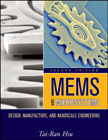
INDICE: Preface. Chapter 1: Overview of MEMS and Microsystems. 1.1 MEMS andMicrosystem. 1.2 Typical MEMS and Microsystems Products. 1.3 Evolution of Microfabrication. 1.4 Microsystems and Microelectronics. 1.5 The Multidisciplinary Nature of Microsystems Design and Manufacture. 1.6 Microsystems and Miniaturization. 1.7 Application of Microsystems in Automotive Industry. 1.8 Application of Microsystems in Other Industries. 1.9 Markets for Microsystems. Problems. Chapter 2: Working Principles of Microsystems. 2.1 Introduction. 2.2 Microsensors. 2.3 Microactuation. 2.4 MEMS with Microactuators. 2.5 Microaccelerometers. 2.6 Microfluidics. Problems. Chapter 3: Engineering Science for Microsystems Design and Fabrication. 3.1 Introduction. 3.2 Atomic Structure of Matters. 3.3 Ions and Ionization. 3.4 Molecular Theory of Matter and Inter-molecular Forces. 3.5 Doping of Semiconductors. 3.6 The Diffusion Process. 3.7 Plasma Physics. 3.8 Electrochemistry. Problems. Chapter 4: Engineering Mechanics for Microsystems Design. 4.1 Introduction. 4.2 Static Bending of Thin Plates. 4.3 Mechanical Vibration. 4.4 Thermomechanics. 4.5 Fracture Mechanics. 4.6 Thin Film Mechanics. 4.7 Overview on Finite Element Stress Analysis. Problems. Chapter 5:Thermofluid Engineering and Microsystems Design. 5.1 Introduction. 5.2 Overview on the Basics of Fluid Mechanics in Macro and Mesoscales. 5.3 Basic Equations in Continuum Fluid Dynamics. 5.4 Laminar Fluid Flow in Circular Conduits. 5.5 Computational Fluid Dynamics. 5.6 Incompressible Fluid Flow in Microconduits. 5.7 Overview on Heat Conduction in Solids. 5.8 Heat Conduction in Multi-layered Thin Films. 5.9 Heat Conduction in Solids in Submicrometer Scale. Problems. Chapter 6: Scaling Laws in Miniaturization. 6.1 Introduction to Scaling. 6.2 Scaling in Geometry. 6.3 Scaling in Rigid-Body Dynamics. 6.4 Scaling in Electrostatic Forces. 6.5 Scaling of Electromagnetic Forces. 6.6 Scaling in Electricity. 6.7 Scaling in Fluid Mechanics. 6.8 Scaling in Heat Transfer. Problems.Chapter 7: Materials for MEMS and Microsystems. 7.1 Introduction. 7.2 Substrates and Wafers. 7.3 Active Substrate Materials. 7.4 Silicon as a Substrate Material. 7.5 Silicon Compounds. 7.6 Silicon Piezoresistors. 7.7 Gallium Arsenide. 7.8 Quartz. 7.9 Piezoelectric Crystals. 7.10 Polymers. 7.11 Packaging Materials. Problems. Chapter 8: Microsystems Fabrication Processes. 8.1 Introduction. 8.2 Photolithography. 8.3 Ion Implantation. 8.4 Diffusion. 8.5 Oxidation. 8.6 Chemical Vapor Deposition. 8.7 Physical Vapor Deposition - Sputtering. 8.8 Deposition by Epitaxy. 8.9 Etching. 8.10 Summary of Microfabrication. Problems.Chapter 9: Overview of Micromanufacturing. 9.1 Introduction. 9.2 Bulk Micromanufacturing. 9.3 Surface Micromachining. 9.4 The LIGA Process. 9.5 Summary on Micromanufacturing. Problems. Chapter 10: Microsystem Design. 10.1 Introduction. 10.2 Design Considerations. 10.3 Process Design. 10.4 Mechanical Design. 10.5 Mechanical Design Using Finite Element Method. 10.6 Design of Silicon Die of a Micropressure Sensor. 10.7 Design of Microfluidics Network Systems. 10.8 Computer-Aided Design. Problems. Chapter 11: Assembly, Packaging and Testing ofMicrosystems. 11.1 Introduction. 11.2 Overview of Microassembly. 11.3 The High Costs of Microassembly. 11.4 Microassembly Processes. 11.5 Major Technical Problems in Microassembly. 11.6 Microassembly Work Cells. 11.7 Challenging Issues in Microassembly. 11.8 Overview of Microsystems Packaging. 11.9 General Considerations in Packaging Design. 11.10 The Three Levels of Microsystems Packaging. 11.11 Interfaces in Microsystems Packaging. 11.12 Essential Packaging Technologies. 11.13 Die preparation. 11.14 Surface Bonding. 11.15 Wire bonding:. 11.16 Sealing and Encapsulation. 11.17 Three-dimensional Packaging. 11.18 Selection of Packaging Materials. 11.19 Signal Mapping and Transduction. 11.20 Design Case on Pressure Sensor Packaging. 11.21 Reliability in MEMS Packaging. 11.22 Testing for Reliability. Problems. Chapter 12: Introduction to Nanoscale Engineering. 12.1 Introduction. 12.2 Micro and Nanoscale Technologies. 12.3 General Principle in Nanofabrication. 12.4 Nanoproducts. 12.5 Applications of Nanoproducts. 12.6 Quantum Physics. 12.7 Molecular Dynamics. 12.8 Fluid Flow in Submicrometer and Nano Scales. 12.9 Heat Conduction in Nanoscale. 12.10 Measurement of Thermal Conductivity. 12.11 Challenges in Nanoscale Engineering. 12.12Social Impacts of Nanoscale Engineering. Problems. Bibliography. Index.
- ISBN: 978-0-470-08301-7
- Editorial: John Wiley & Sons
- Encuadernacion: Cartoné
- Páginas: 560
- Fecha Publicación: 09/04/2008
- Nº Volúmenes: 1
- Idioma: Inglés
